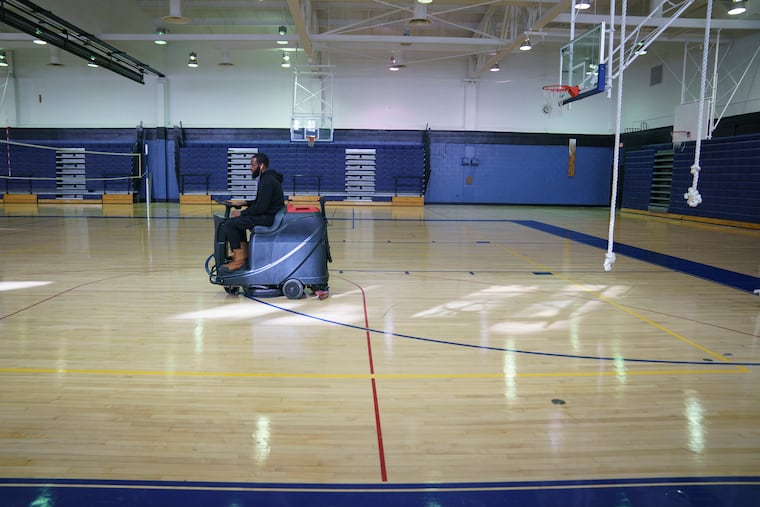Students will get back inside Ben Franklin High, SLA after a long delay, $50M in renovations
The Ben Franklin project laid bare problems not only with asbestos and other environmental issues, but also with district processes and communications writ large. The district’s Inspector General is investigating what went wrong. “We learned a lot over over the past several months,” Hite said.

Five months after students last attended classes in the sprawling building at Broad and Green Streets, Benjamin Franklin High and Science Leadership Academy students are going back in on Tuesday.
The two schools had to vacate their building for temporary locations in October amid damaged asbestos and problems with a $37 million renovation job to upgrade the Ben Franklin building as SLA, the elite magnet school, moved in. The delay and environmental clean-up will put the final project cost at as much as $50 million, Superintendent William R. Hite Jr. said.
Construction was largely finished in January, said Hite, who led a press tour Monday, but officials used the extra time to take hundreds of air samples and thoroughly clean the building — which Hite said is now “completely asbestos safe.” The Philadelphia Federation of Teachers’ environmental director has also signed off on re-occupancy.
“At this point, there’s no indication that anyone should have any problems,” said Jim Creedon, interim operations director. Creedon was a district consultant who was brought on after the work at Ben Franklin and other jobs developed problems.
Almost 1,000 students were supposed to return to the building at the beginning of the school year, but construction delays pushed the two schools’ start dates back. Once pupils reported back, it became clear that the environmental conditions in the still-under-construction building were not suitable for occupancy, with students and teachers reporting health issues. (Students and staff from Ben Franklin, a neighborhood high school with no admissions criteria, said the conditions had been much worse for them during the 2018-19 school year, when renovations began.)
Students will return to a vastly different space Tuesday.
When they last attended classes in the building, the entire sixth floor was closed to them and the kitchens were nonfunctional. Now, the sixth floor shines, and “Ben’s Den” and the “Launch Pad Cafe,” full-service cafeterias for Ben Franklin and SLA respectively, will be open for business. The gym has new flooring, seating, and paint. Every window in the building has new glass that lets more light shine through.
Unpacking and setting up the engineering lab on the SLA side, teacher John Kamal predicted wide-eyed students on Tuesday. SLA was temporarily located at Philadelphia School District headquarters just a block down North Broad Street, and Ben Franklin moved further north, to the old Khepera Charter School building near Temple University Hospital.
“We got through it,” Kamal said of the relocation. His engineering students were hampered by the lack of a proper lab space and equipment. They mostly studied theory, with a few tools brought in when feasible.
“The kids are so excited to get in and start making things,” Kamal said.
“It’s a transformed building,” said Creedon.
Past the sixth-floor SLA digital video and engineering labs and art room is a courtyard with tables, plenty of open space, and gorgeous views of the city.
“This is how city education should be,” Hite said, looking south to City Hall.
Students will still have separate entrances, classrooms, gyms, and eating spaces, with Ben Franklin occupying the Broad Street side of the building and SLA the 15th Street side. Students will have some opportunities to work together in extracurricular activities.
The Ben Franklin construction project and subsequent asbestos discovery laid bare problems not just with asbestos and other environmental issues, but also with district processes and communications. The district’s inspector general is investigating what went wrong.
» READ MORE: Read more: Missed asbestos, dangerous dust: what went wrong on the Ben Franklin-SLA project
“We learned a lot over the past several months,” Hite said on Monday.
For starters, the district will no longer green-light major construction projects before handling asbestos jobs, Hite said, adding that the school system would take “a more holistic approach to asbestos abatement." Going forward, he said, “if we’re going to do a renovation or modernization, we’re going to go in and remove all of the environmental hazards.”
More than 75% of district buildings contain asbestos. To date, 10 schools have had to close because of damaged asbestos, with work underway or planned at many more. The superintendent has said that the district needs $125 million in new funding over five years to make all buildings lead- and asbestos-safe.
» READ MORE: Read more: Asbestos delays students' return to Feltonville school
The Philadelphia Federation of Teachers and some state and federal politicians have called for the district to be declared in a “state of emergency” over the asbestos crisis. Hite stopped short of that.
“We need an emergency funding source that we can rely on year after year,” the superintendent said.
Teachers, tradespeople, and other workers were on site Monday, unpacking boxes, placing equipment, and readying classrooms and other areas for students. Steve Cohen, father of an SLA junior, showed up to tackle boxes on the second floor as a way of saying thanks to the staff who made a difficult several months bearable.
"These kids have been without a school for a long time, and the educators have been amazing,” Cohen said.
A few construction projects remain to be finished at the school — including renovating some bathrooms and locker rooms — but those jobs will not be undertaken until the summer.